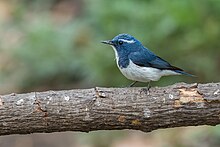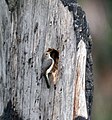| Ultramarine flycatcher | |
|---|---|

| |
| Male from Pangot village of Nainital district of Uttarakhand, India | |
| Conservation status | |
 Least Concern (IUCN 3.1) | |
| Scientific classification | |
| Domain: | Eukaryota |
| Kingdom: | Animalia |
| Phylum: | Chordata |
| Class: | Aves |
| Order: | Passeriformes |
| Family: | Muscicapidae |
| Genus: | Ficedula |
| Species: | F. superciliaris |
| Binomial name | |
| Ficedula superciliaris (Jerdon, 1840) | |
The ultramarine flycatcher or the white-browed blue flycatcher (Ficedula superciliaris) is a small arboreal Old World flycatcher in the Ficedula genus that breeds in the foothills of the Himalayas and winters in southern India.
Description

Somewhat smaller in size than a sparrow (ca. 10 cm) and with a stocky build. The male is deep blue above, sides of head and neck are deep blue, and a prominent white patch runs from centre of throat, through breast to belly. The amount of white on the brow and tail show clinal variation from West to East along the Himalayan foothills, which is sometimes taken to distinguish three subspecies:
- The western subspecies from the western Himalayas has a distinctive white supercilium and white bases to the outer tail feathers.
- The eastern subspecies (Ficedula superciliaris aestigma) from the eastern Himalayas lacks distinct white patches.
- The population from the south Assam hills (sometimes designated a third subspecies cleta) completely lack any supercilium.
Usually singly, though sometimes in mixed hunting parties in the winter. Keeps largely to the low trees and bushes, feeding among the foliage canopy, not venturing much into the open. Constantly jerks up its tail, often accompanied by fluffing of head feathers and trrr note, especially in proximity of nest. Diet is mainly insects.
Distribution
Summer: Common breeding visitor to the western Himalayas, from Jammu and Kashmir and Himachal Pradesh to Uttarakhand (western race), and intergrading within Nepal with the eastern race Ficedula superciliaris aestigma which continues in the eastern Himalayas through Bhutan to Arunachal Pradesh. Breeding between 2000 and 2700 m, occasionally as low as 1800 m and as high as 3200 m. Also in the lower hills of Meghalaya and Nagaland, Khasi and Cachar hills, sometimes considered a third race; winter movements of this population are not known. Habitat: Open, mixed forests of oak, rhododendron, pine, fir, etc., occasionally orchards.
Winter: Central India from Delhi south to northern Maharashtra, Goa, and eastward to Andhra Pradesh and Odisha. Wintering populations in the eastern states, possibly from Nepal/Sikkim, are mixed: a good part of this population also have a white supercilium and basal tail patches (see description below). Also sometimes found as a vagrant in the northern part of Bangladesh.
Nesting
- Season: middle of April to early July
- Nest: soft structure of fine moss with some strips of bark and fine grass, lined with hair and rootlets, placed in holes or clefts in trees, at heights up to seven meters, or in a depression on a steep bank. Readily takes to nest boxes in hill station gardens.
- Eggs: 3 to 5, usually 4, olive greenish to dull stone-buff, densely freckled all over with reddish brown, or in another type, mostly around the large end, forming a cap. Average size 16x12.2 mm.
Foraging Behavior
Typically they respond to indirect cues more than direct cues in relation to risk management when foraging for food.
Gallery
-
 Male from Himachal Pradesh, India
Male from Himachal Pradesh, India
-
 Female at Kullu - Manali District of Himachal Pradesh, India
Female at Kullu - Manali District of Himachal Pradesh, India
-
 Female at Sattal, India
Female at Sattal, India
-
 Male from Phoolchoki Forest, Godawari, Lalitpur Nepal.
Male from Phoolchoki Forest, Godawari, Lalitpur Nepal.
References
- BirdLife International (2020). "Ficedula superciliaris". IUCN Red List of Threatened Species. 2020: e.T22709406A181848930. doi:10.2305/IUCN.UK.2020-3.RLTS.T22709406A181848930.en. Retrieved 11 November 2021.
- Ali, Salim; Sidney Dillon Ripley (2001) . Handbook of the Birds of India and Pakistan, 2nd ed.,10 vols (2nd ed.). New Delhi: Oxford University Press.Bird Number 1421-1422 (races F.s.superciliaris and F.s.aestigma), vol. 7, p. 166-168.
- "Ultramarine Flycatcher (Ficedula superciliaris) :: xeno-canto". www.xeno-canto.org.
- Fong, Tracy E. “The Importance of Indirect Cues for White-Browed Sparrow-Weaver ( Plocepasser Mahali) Risk Assessment.” Acta Ethologica, vol. 12, no. 2, 10 Jan. 2009, pp. 79–85. Ebscohost, white-browed sparrow-weaver.
| Taxon identifiers | |
|---|---|
| Ficedula superciliaris | |